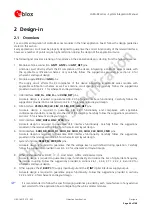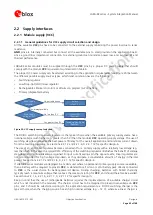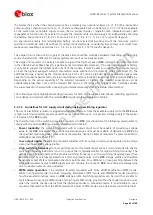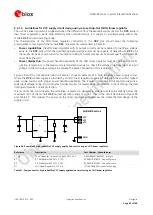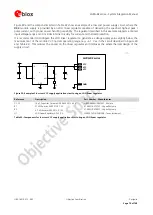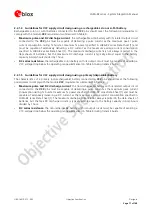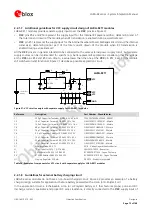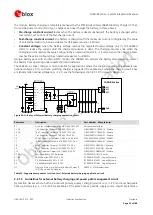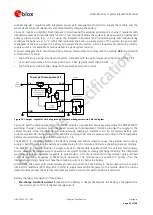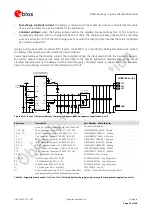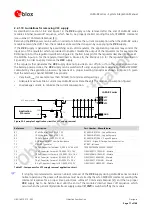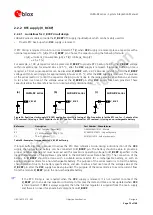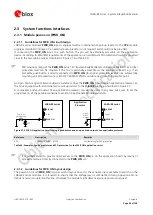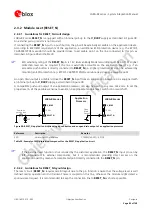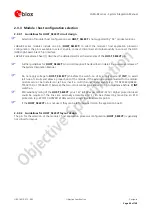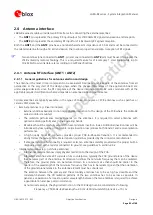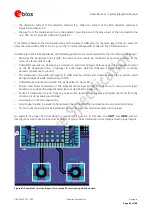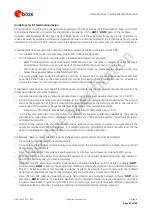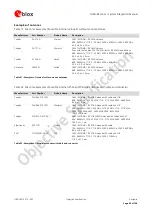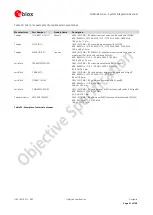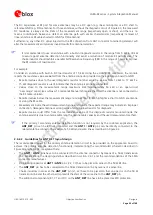
LARA-R2 series - System Integration Manual
UBX-16010573 - R02
Objective Specification
Design-in
Page 78 of 148
2.2.1.11
Guidelines for VCC supply layout design
Good connection of the module
VCC
pins with DC supply source is required for correct RF performance.
Guidelines are summarized in the following list:
All the available
VCC
pins must be connected to the DC source.
VCC
connection must be as wide as possible and as short as possible.
Any series component with Equivalent Series Resistance (ESR) greater than few milliohms must be avoided.
VCC
connection must be routed through a PCB area separated from sensitive analog signals and sensitive
functional units: it is good practice to interpose at least one layer of PCB ground between
VCC
track and
other signal routing.
Coupling between
VCC
and audio lines (especially microphone inputs) must be avoided, because the typical
GSM burst has a periodic nature of approx. 217 Hz, which lies in the audible audio range.
The tank bypass capacitor with low ESR for current spikes smoothing described in section 2.2.1.6 should be
placed close to the
VCC
pins. If the main DC source is a switching DC-DC converter, place the large
capacitor close to the DC-DC output and minimize the
VCC
track length. Otherwise consider using separate
capacitors for DC-DC converter and cellular module tank capacitor.
The bypass capacitors in the pF range described in section 2.2.1.6 should be placed as close as possible to
the
VCC
pins. This is highly recommended if the application device integrates an internal antenna.
Since
VCC
is directly connected to RF Power Amplifiers, voltage ripple at high frequency may result in
unwanted spurious modulation of transmitter RF signal. This is more likely to happen with switching DC-DC
converters, in which case it is better to select the highest operating frequency for the switcher and add a
large L-C filter before connecting to the LARA-R2 series modules in the worst case.
Shielding of switching DC-DC converter circuit, or at least the use of shielded inductors for the switching
DC-DC converter, may be considered since all switching power supplies may potentially generate interfering
signals as a result of high-frequency high-power switching.
If
VCC
is protected by transient voltage suppressor to ensure that the voltage maximum ratings are not
exceeded, place the protecting device along the path from the DC source toward the cellular module,
preferably closer to the DC source (otherwise protection functionality may be compromised).
2.2.1.12
Guidelines for grounding layout design
Good connection of the module
GND
pins with application board solid ground layer is required for correct RF
performance. It significantly reduces EMC issues and provides a thermal heat sink for the module.
Connect each
GND
pin with application board solid GND layer. It is strongly recommended that each
GND
pin surrounding
VCC
pins have one or more dedicated via down to the application board solid ground layer.
The
VCC
supply current flows back to main DC source through GND as ground current: provide adequate
return path with suitable uninterrupted ground plane to main DC source.
It is recommended to implement one layer of the application board as ground plane as wide as possible.
If the application board is a multilayer PCB, then all the board layers should be filled with GND plane as
much as possible and each GND area should be connected together with complete via stack down to the
main ground layer of the board. Use as many vias as possible to connect the ground planes
Provide a dense line of vias at the edges of each ground area, in particular along RF and high speed lines
If the whole application device is composed by more than one PCB, then it is required to provide a good and
solid ground connection between the GND areas of all the different PCBs.
Good grounding of
GND
pins also ensures thermal heat sink. This is critical during call connection, when the
real network commands the module to transmit at maximum power: proper grounding helps prevent
module overheating.

